
Original Link: https://www.anandtech.com/show/2696
System Buyers Guide: PCs for Under $1000
by Wesley Fink on December 29, 2008 3:00 AM EST- Posted in
- Guides
Introduction
In the last few weeks we've looked at almost all the components you would need to build your new PC. This includes motherboards, memory, cases and power supplies, video cards, displays, and storage. Now it is time to put all these parts together into a couple of systems buyers' guides.
Since we have already covered component classes and individual items in detail in the recent component guides, you will find those a useful reference to the components chosen in these system guides. This guide will take a closer look at several complete systems you can build for $500 to $1000 these days. Next week, we will look more closely at midrange systems in the price range of $1000 to $2000.
Low-end PCs have a reputation for being substandard, underpowered, and barely better than off-the-shelf PCs. That certainly has been true in the past, but with the continuing drop in component prices, you can get a lot of PC for your $500 to $1000. About a year ago it would cost about $700 to $750 to put together a decent "entry" system. Today you can build a similar but more powerful system, for about $200 less.
The fierce competition between Intel and AMD on the CPU front, and between AMD/ATI and NVIDIA in the GPU market, have made it possible to buy quality components for prices that used to be reserved for outdated hardware. You just have to know what to look for. The closeouts and "gotchas" are still out there, but armed with a little knowledge you can navigate the components offered and end up with a really powerful computer for the money you spend.
In this guide we will be looking at three common categories of systems you can now buy for under $1000. This includes the Entry-level PC, which is the best value for a complete system costing around $500. The bar is then raised to the upper end of our budget price range with Budget PCs that feature the most bang for the buck closer to the $1000 price point. It was a bit of surprise to find you could build very capable AMD and Intel machines, complete with keyboard, mouse, operating system, video card, 4GB of memory, and 19" wide-screen monitor for less than $850, leaving room for a monitor or graphics upgrade while still remaining under $1000.
Finally, we put together basic HTPC computers to deliver video content to your Home Theater. HTPC builders have normally already selected a display/TV for video and have a sound system, so we did not include either the display or speakers in the basic HTPC component selections. That is a subject for another article.
In the "Under $1000" PC market it really does not matter if you select AMD or Intel for your CPU. Performance across both lines is very competitive at the same price points in this category. That is why both AMD and Intel systems are presented at each price point. If we were choosing a high-end system at this moment the only real choice would be Intel, but with Phenom II around the corner that may soon change.
While the Intel i7 is a recent introduction and Phenom II is coming in about two weeks, both new processors will have the greatest impact at the upper middle to the top-end CPU offerings. The impact on the sub-$1000 category should be very small, consisting mostly of minor price cuts on "outdated" hardware and platforms. PCs in the "under $1000" category also frequently utilize onboard graphics, and there is no expectation for a new blockbuster IGP chipset on the horizon. While change is a constant in the computer industry, you can build PCs for less than $1000 today with some confidence that the system will continue to provide competitive performance for a reasonable period of time.
All of our recommendations are also upgradable, so you can add the latest video card and turn the system into a reasonable gaming or graphics processing system if you choose (provided your PSU is up to snuff, of course). GPUs deliver exceptional performance at the lowest price points seen in many years. The storage recommendations may seem overkill to some, but there is little reason to choose a smaller hard drive when you can buy 500GB of hard drive storage for $59 and a 1000GB (1TB) drive for just $110. Now let's get to the recommendations.
AMD Entry-level PC
Compared to a year ago our Entry AMD system uses a dual-core CPU with the same 2.6GHz speed. This year that CPU costs over 40% less and consumes half the power of last year's X2. That is certainly progress. With memory so cheap, we have also doubled our recommendation to 4GB. You can go with 2GB and save $13, but that money is well spent in doubling memory, particularly if you want to jump on the Vista 64-bit bandwagon, and honestly we see very few reasons to hold off. The hard drive is now 500GB, doubling the capacity from a year ago for the same price.
| AMD Entry-level PC | ||
| Hardware | Component | Price |
| Processor | Athlon 64 X2 5050E Brisbane (Dual-core 2.6GHz 45W 2x512KB L2) |
$63 |
| Cooling | CPU Retail HSF | - |
| Video | Onboard | - |
| Motherboard | ASRock A780GXE/128M 780G | $80 |
| Memory | Kingston 4GB DDR2-800 Kit (KVR800D2N5K2/4G) | $37 |
| Hard Drive | WD Caviar GP WD5000AACS 500GB | $59 |
| Optical Drive | Samsung 22X DVDRW/DL SH-S202G | $25 |
| Audio | Onboard | - |
| Case | Rosewill TU-155 with 400W | $60 |
| Power Supply | Included with Case | - |
| Display | Hanns-G HB-175APB 17" 8ms Widescreen LCD Monitor Built in Speakers - Retail (1440x900) | $99 |
| Speakers | Built into Monitor | - |
| Input | Microsoft CA9-00001 PS/2 Standard Keyboard and Optical USB/PS2 Mouse - OEM | $16 |
| Operating System | Microsoft Vista Home Premium OEM | $99 |
| Bottom Line | $538 | |
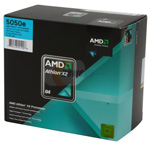 |
Prices on all processors are continuing to drop in the face of the continued, aggressive pricing strategy adopted by Intel. The AMD 2.6GHz dual-core is an excellent value at just $63. If you want even more power the Phenom 8750 tri-core is a good value at just $57 more, and that also moves you to the Phenom architecture instead of the older K8. However, for most users the Athlon 64 X2 5050E provides plenty of power for an entry AMD system. If you're counting pennies you could even drop down to a single-core 2.6GHz Orleans 45W processor for $36 and save $27.
The 780G chipset is one of the best budget IGP designs we have worked with over the years. This is the chipset that made integrated graphics relevant again. One of the best boards in this price category is the ASRock A780GXE. The A780GXE features the ATI Radeon 3200 integrated graphics. ASRock loads the board with six 3Gb/s SATA ports featuring RAID 0/1/10, 5.1 HD audio, Gigabit LAN, two PCI-E x16 slots, one PCI-E x1 slot, three PCI slots, and support for 16GB of memory. Durability is addressed with solid capacitors for CPU power and duracap long-life capacitors for the rest. This board has been rock solid for us and supports AM2/AM2+ and the upcoming AM3.
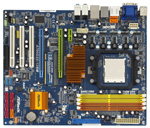 |
The 780GXE has 128MB of sideport memory for additional performance. It fully supports the 140W Phenoms, and it can do dual x8 Crossfire. The 780GXE used to be a $90 board, so it is a good value at the current $80 price. It is ATX format, and ASRock also manufactures the 780FullDisplayPort motherboard, which at $10 less may be a better choice for those pinching pennies. The extra performance of sideport memory for the $10 price difference is worth it. However, for those who never worry about upgrades, the A780FullDisplayPort is a great choice, plus ASRock is currently throwing in a DisplayPort card and DVI to HDMI converter with the 780FullDisplayPort.
With DDR2 prices so very low, we went for 4GB of DDR2-800 this time. This is double last year's entry recommendation for less than half the price. This 50% to 75% drop in DDR2-800 memory prices in the past year is why you're not seeing much memory advertising these days. RAM prices as a whole are certainly in the commodity category as of late. We recommended the Kingston 4GB DDR2-800 kit, but you could just as easily choose OCZ, G.Skill, Corsair, Crucial, GeIL, Patriot, or any other quality DDR2-800 name and shop for the memory based on a combination of price and the company's support reputation. Again, if you are truly pinching pennies you can save about $13 by going with 2GB of memory instead.
Hard drive capacity continues to grow, as you can see in our selection of the Western Digital Caviar 500GB for our entry system. It seems a waste to choose a lower HD capacity when 500GB is now available for around $60 - even from www.amazon.com. While there are differences between hard drives, outside of running benchmarks most people aren't likely to notice the difference in performance between Western Digital, Seagate, Samsung, Hitachi, and other major brands. All are worthy of consideration if the price per gigabyte (or terabyte) is right.
For the optical drive we went for value with the dependable Samsung 22X DVDR. With the rise of the 25GB/50GB Blu-Ray burners, DVD writers have continued to drop in price. A DVD writer that supports double-layer and 22X DVD writes for $25 is a bargain indeed.
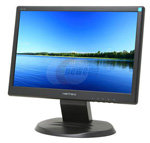 |
The last major component to discuss is the display, and here the tilt was toward price. $99 is a really low price for an LCD monitor, and the Hanns-G is a 17" widescreen that supports a native resolution of 1440x900. This is the resolution supported by most 19" and 20" widescreen monitors. You will not give up resolution with this monitor, but things will be a bit smaller. If your budget allows, you can choose the 19" Acer X193Wb with the same 1440x900 resolution at $130, or a 22" Acer X223Wbd, with 1680x1050 resolution for $170. LCD monitors have dropped in price, moved to widescreen format, and generally improved in image quality, even with the lower prices. 22" is today's sweet spot, since the next step up to 24" starts at around $300. If your budget can stretch to $170, that is money well spent on a 22" widescreen display.
Intel Entry-level PC
While Intel still owns the top of the CPU performance charts, the area from midrange to entry is very competitive between Intel and AMD. The one advantage that remains for Intel is that their processors generally overclock much better than current AMD CPUs. This is not normally a consideration in entry computers, but it could be for some buyers.
| Intel Entry-level PC | ||
| Hardware | Component | Price |
| Processor | Intel Pentium Dual-Core E5200 Wolfdale (Dual-core 2.5GHz 65W 2MB Shared L2 800FSB) |
$83 |
| Cooling | CPU Retail HSF | - |
| Video | Onboard | - |
| Motherboard | Zotac N73PV-Supreme NVIDIA GeForce 7100 HDMI | $60 |
| Memory | Kingston 4GB DDR2-800 Kit (KVR800D2N5K2/4G) | $37 |
| Hard Drive | WD Caviar GP WD5000AACS 500GB | $59 |
| Optical Drive | Samsung 22X DVDRW/DL SH-S202G | $25 |
| Audio | Onboard | - |
| Case | Rosewill TU-155 with 400W | $60 |
| Power Supply | Included with Case | - |
| Display | Hanns-G HB-175APB 17" 8ms Widescreen LCD Monitor Built in Speakers - Retail (1440x900) | $99 |
| Speakers | Built-in Monitor | - |
| Input | Microsoft CA9-00001 PS/2 Standard Keyboard and Optical USB/PS2 Mouse - OEM | $16 |
| Operating System | Microsoft Vista Home Premium OEM | $99 |
| Bottom Line | $538 | |
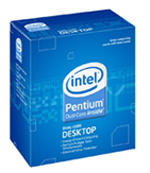 |
Our choice for the Intel entry CPU is the excellent 2.5GHz dual-core E5200 Wolfdale. This 65W CPU uses 800FSB, so right out of the box the first option for overclock, if you are so inclined, is to bump the FSB up to 1066. Even if you never overclock you will be very pleased with the performance of the E5200. We do not recommend going lower than an E5200 in an Intel system because the tradeoffs in performance for the few dollars saved are too great. The E1200 at $53, for example, is dismal compared to the E5200, and certainly not a good choice in performance for the $30 saved.
 |
In the past year, some motherboards for Intel systems have finally reached price parity with AMD systems. One example is the Zotac board chosen for the entry Intel system. The ZOTAC N73PV-Supreme is based on the GeForce 7100. This uATX motherboard features HDMI output, Gigabit LAN, four 3Gb/s SATA ports, 10 USB ports, HD audio, one PCI-E x16 slot, one PCI-E x1 slot, two PCI slots, and support for 4GB RAM. This board offers excellent stability and performance for the money. Pair it up with an E5200 and 4GB of DDR2-800 and you have a solid SOHO system
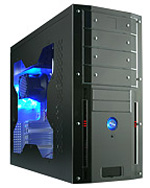 |
The rest of the components are virtually identical to the AMD entry-level system. This includes the Rosewill TU-155 case with 400W PSU from Newegg. It is a versatile case that will house any entry to midrange system at a current cost of $60. The TU-155 with PSU often goes on sale for $50 so it pays to shop if it is important to save every dollar possible. We generally do not recommend cases that come with a power supply, but our long-term experience with this 400W PSU has been positive with no problems - though certainly efficiency isn't going to compete with PSUs that cost as much on their own as this case/PSU combo. If you're interested in getting a better quality, higher efficiency 300-450W PSU, we'll have a couple massive roundups in the near future, so check back later this week.
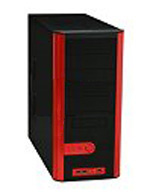 |
A good case alternative is the well-known Cooler Master Centurion 5 Red FR-T05-URI-GP with 430W power supply for the same $60. This black case with red trim stands out in both appearance and in its flexible interior that can handle five 5.25" devices, two 3.5" devices, and three internal hard drives. There is also an installed 120mm exhaust fan on the rear in the CPU area.
If we compare the two entry-level systems, the winner depends on what you value most. The Intel system is a bit more powerful, but you can move up to a high-end Athlon 64 X2 or a low-end AMD Phenom X3 for comparable performance at less than $100. The full-size AMD ASRock board offers more flexibility for future graphics expansion, with two x16 PCIe slots and Crossfire X support. If you are a gamer on a strict budget, the AMD entry system offers you more options for future graphics expansion. For the typical entry-level PC right now, and for what the system is typically used for - internet, office, low-end gaming, and low to mid graphics - you can go either route and be happy.
AMD Budget
Leaving the entry-level sector behind, and with a budget of up to $1000, our options increase significantly. Our aim here is to provide a configuration that allows for a nice balance of performance at stock speeds. This doesn't mean you have to spend the entire $1000 though, as prices have dropped in the past year and performance for the dollar has definitely increased. In fact, both budget systems are under $850 complete, giving you the option to increase graphics power or go for a larger monitor (or both) and still be around $1000.
The assembled system is balanced for a wide variety of computing tasks, but final tweaks can tilt it toward gaming or graphics for example, if that is what you aim for. Generally we consider PC gaming rigs to begin at the next category, or the low end of midrange, but adding a more powerful graphics card and a larger monitor will definitely make one of these budget systems a good choice for entry gaming at around $1000. If that is your goal take a look at our Holiday 2008 GPU and Holiday 2008 Display guides for help in selecting a graphics card and display for your price point.
| AMD Budget PC | ||
| Hardware | Component | Price |
| Processor | Phenom 8750 Black Edition (Tri-core 2.4GHz 95W 3x512KB L2) |
$120 |
| Cooling | CPU Retail HSF | - |
| Video | Powercolor AX4830 512MD3-H Radeon HD 4830 | $85 |
| Motherboard | Biostar TForce TA790GX3 A2+ | $110 |
| Memory | Crucial Ballistix 4GB DDR2-800 Kit (BL2KIT25664AA80A) | $48 |
| Hard Drive | WD Caviar GP WD6400AACS 640GB | $85 |
| Optical Drive | Samsung 22X DVDRW/DL SH-S202G | $25 |
| Audio | Onboard | - |
| Case | Antec Three Hundred ATX Mid-Tower Case | $60 |
| Power Supply | OCZ ModXStream Pro OCZ400MXSP 400W ATX12V V2.2 Modular Active PFC Power Supply | $35 |
| Display | Acer X193W+BD 19" 5ms Widescreen LCD Monitor (1680x1050) | $130 |
| Speakers | Logitech R-20 12 Watts RMS 2.1 Multimedia Speaker | $18 |
| Input | Microsoft CA9-00001 PS/2 Standard Keyboard and Optical USB/PS2 Mouse - OEM | $16 |
| Operating System | Microsoft Vista Home Premium OEM | $99 |
| Bottom Line | $831 | |
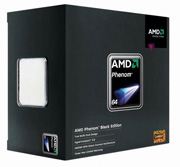 |
While the GPU is the most important factor in gaming performance, the CPU is also a factor - particularly below 1280x1024. To make sure the CPU is not a bottleneck now, or in the near future should you upgrade your PC, a Black Edition Phenom X3 is the CPU of choice. The Phenom 8750 Black Edition has an unlocked multiplier should you choose to overclock, which makes overclocking as simple as it gets. It is rated at 2.4GHz 95W at stock, with 3x512KB L2 cache.
 |
We've paired the Phenom 8750 Black Edition with the Biostar TForce TA790GX3 A2+, a perfect match for those looking to squeeze as much performance out of their money as possible. The Biostar is loaded with overclocking features, including integrated AMD HD 3300 graphics with an HDMI/DVI interface with 1080P HD support. This adds up to very decent performance using the onboard graphics. In addition to AM2+ support, Biostar claims future AM3 CPU support. Biostar includes 128MB DDR2 sideport memory for improved GPU performance, Realtek ALC 888 HD audio, Gigabit LAN, 16GB memory support, six 3Gb/s ports capable of RAID 0/1/10/5, 10 USB ports, two PCI-E x16 slots (dual x8 CrossFire), two PCI-E x1 slots, and two PCI slots. The BIOS caters to the casual overclocker and this board performs very well in a variety of tests. .
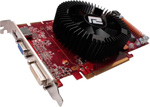 |
Graphics are provided by the PowerColor Radeon HD 4830. 4830 video cards are normally in the $110 to $130 price range, so $85 for an Radeon 4830 after rebate is an incredible value and allows the graphics to be kicked up to a higher level. At low to moderate resolutions (1024x768 to 1680x1050) gamers using this class of GPU hardware are all but guaranteed to be able to play with all the effects and high image quality options enabled. That makes the 4830 a good match to the other components in our Bargain systems.
We're going with the Ballistix 4GB DDR2-800 kit for $48. However, there are many memory options at great prices today. Quality DDR2-800 RAM from Corsair, OCZ, G.Skill, Mushkin, and GeIL are available on any of the major online retailers. Just be sure to look for RAM with timings of 4-4-4-12 - or even better with a little luck.
The hard drive receives a slight capacity upgrade to a 640GB Western Digital Caviar. If you'd prefer a longer warranty, look at Seagate, which includes a 5-year warranty on most of their drives for a few dollars more. The DVD burner remains the same Samsung 22X.
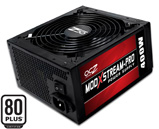 |
The case receives an upgrade with the selection of the well-regarded Antec Three Hundred and a bargain OCZ ModXStream Pro 400W power supply. OCZ power supplies have a great reputation for solid performance and good warranty support, and $35 after rebate is a great price for a quality power supply.
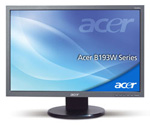 |
The LCD display was a bit of a conundrum. We selected the high resolution Acer X193W+BD for $130. Where else can you find a 19" monitor with the 1680x1050 resolution more common on a 22" screen? If you prefer a larger screen you can find a 22" widescreen for just $40 more, but the resolution will be the same.
If you plan to do a lot with 1080P HD you should consider a monitor that will support the 1080P resolution of 1920x1080. Generally this is the resolution expected of 24" LCD Monitors, which start at around $300. That is a great price compared to the $1000 of just a couple of years ago, but there are even cheaper options available.
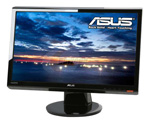 |
The new class of 21.5" monitors feature a true 1080P resolution and we found the Acer H213H 21.5" HDMI 16:9 and the ASUS VH222H Black 21.5" HDMI Widescreen both selling for $200 with free shipping at Newegg. That is just a little bit more for full HD 1920x1080 native resolution.
 |
If you want more video power for gaming, you can upgrade to the Radeon HD 4850 as the start of true HD gaming for just $45 more ($130). An upgrade to the Radeon HD 4870 512MB can be as little as $180 (just $95 more). The $130 and $180 cards still keep your total well below $1000. You can even upgrade to the $180 4870 and include the full HD 21.5" Acer or ASUS monitor and still be at $996 to $1001. That's a very capable gaming system for $1000 that can do plenty of tasks besides gaming should the need arise.
Intel Budget
While Intel offerings have tended to be more expensive than configurations from AMD, our Intel and AMD budget PCs are all but the same price with just a $2 difference. With prices all but the same you can choose your budget system based on other features that are important to you.
| Intel Budget PC | ||
| Hardware | Component | Price |
| Processor | Intel Core 2 Duo E7300 Wolfdale (Dual-core 2.66GHz 3MB Shared L2 1066FSB) |
$120 |
| Cooling | CPU Retail HSF | - |
| Video | Powercolor AX4830 512MD3-H Radeon HD 4830 | $85 |
| Motherboard | Gigabyte GA-EP45-UD3R | $120 |
| Memory | G.Skill 4GB DDR2-800 Kit (KVR800D2N5K2/4G) | $40 |
| Hard Drive | WD Caviar GP WD6400AACS 640GB | $85 |
| Optical Drive | Samsung 22X DVDRW/DL SH-S202G | $25 |
| Audio | Onboard | - |
| Case | Antec Three Hundred ATX Mid-Tower Case | $60 |
| Power Supply | Corsair CMPSU-400CX 400W ATX12V V2.2 80 PLUS Certified | $35 |
| Display | Acer X193W+BD 19" 5ms Widescreen LCD Monitor (1680x1050) | $130 |
| Speakers | Logitech R-20 12 Watts RMS 2.1 Multimedia Speaker | $18 |
| Input | Microsoft CA9-00001 PS/2 Standard Keyboard and Optical USB/PS2 Mouse - OEM | $16 |
| Operating System | Microsoft Vista Home Premium OEM | $99 |
| Bottom Line | $833 | |
 |
The E7300 ups the bus to 1066 from the 800FSB of our entry-level Intel system. A dual-core 2.66GHz with 3MB of cache won't be a slouch in any department in your budget system. Yes, the new i7 is faster, but it is also much more expensive - especially once you factor in the cost of the motherboard and DDR3 memory on top of the CPU! The question for a budget system is how good the performance is for the money spent. The E7300 SYSmark 2007 score is about 72% of the very top Core i7 965 Extreme (all other components being the same). That is fantastic performance for a CPU that costs just $120. The E7300 is also a candidate for overclocking if you are inclined to move the performance a bit closer toward the 3.33GHz Core 2 Duo E8600, which reaches 88% of the i7 965 Extreme in SYSMark.
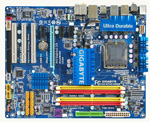 |
The Gigabyte GA-EP45-UD3R is a favorite budget board among the AnandTech staff, mostly because nothing about the board makes you think it is a budget board. It is an excellent match to the overclocking potential of the E7300 CPU. Gigabyte features the P45 and ICH10R chipsets. Gigabyte also includes the Realtek ALC 889a HD audio codec, Gigabit LAN, 16GB memory support, six 3Gb/s ports capable of RAID 0/1/10/5, two additional 3Gb/s SATA ports, IEEE 1394A, 12 USB ports, and Gigabyte's Ultra Durable 3 technology.
The BIOS caters to the overclocker and this board just performs great. Our E8600 easily reached 540FSB if that is important to you and did it in a very stable manner. Gigabyte also tosses in their EasyTune 6 application along with their DualBIOS technology. All in all, this is one of the better "budget performance" boards we have used in a long time.
 |
By this time, you may be wondering why we chose not to include an aftermarket CPU heatsink to go along with our CPU choices. For this budget, a $50 solution from Thermalright or Scythe is not an option without cutting some other area, but with the stock AMD and Intel heatsinks incorporating heatpipe technology, we figured we'd still be good for a decent if not spectacular overclock.
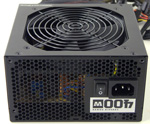 |
The Power Supply choice for the Intel Budget system is the same final price of $35 after rebate as the AMD Budget system. However, we have changed the PS choice to the Corsair CMPSU-400CX 400W power supply. The OCZ ModXStream 400W used on the AMD has a 4-pin CPU power connector, while the Gigabyte GA-EP45-UD3R motherboard for this Intel system has an 8-pin socket. Normally, using a 4-pin connector in the 8-pin socket is not a problem, but some have reported issues with a 4-pin CPU power connector on the 8-pin connector of the Gigabyte board. To play it safe we have recommended the Corsair 400W power supply for this Intel Budget system.
The rest of the components are the same as those found in the AMD budget system. Sound cards at this price range are simply an unnecessary luxury, and the onboard offerings continue to improve with each new motherboard generation. You can be reasonably happy with the onboard sound until you figure out if you want to go further with sound and exactly where you might want to go.
AMD HTPC
Everyone asks for HTPC component recommendations, and then when we publish them readers can't wait to throw rocks at our recommendations. Perhaps this is because the HTPC, more than any other computer class, is a very personal machine. It needs to meet the specific needs and demands of the end-users, who vary widely in what they plan to do with their new HTPC.
So let's first talk about our concept in these two HTPC configurations. We are assuming the user already has the HDTV (likely) or monitor he plans to feed, along with a sound system for that HDTV. The motherboards we recommend can reasonably feed audio signals for your Blu-Ray movies, but they are not integrated audio amplifiers. Since most end-users are on cable or satellite, and analog tuners become officially obsolete in the US in February 2009, we will make no recommendations at all for a TV tuner. Of the many possible uses of an HTPC, the great majority of end-users store, play, and stream movies with their HTPC computers. (Where these movies come from is a different topic that we'll avoid discussing for now.) That is mostly what their HTPC systems are used for and that is where we have concentrated our recommendations.
| AMD HTPC System | ||
| Hardware | Component | Price |
| Processor | AMD Phenom 8650 Toliman - Retail (Tri-Core 2.3GHz 95W 3x512KB L2, 2MB Shared L3, Socket AM2+) | $97 |
| Cooling | CPU Retail HSF | - |
| Video | Onboard | - |
| Motherboard | ASUS M3N78-EM | $90 |
| Memory | 4GB DDR2-800 - G.Skill F2-6400CL5D-4GBPQ | $40 |
| Hard Drive | Western Digital Caviar Green WD10EACS 1TB SATA 3.0Gb/s Hard Drive - OEM | $105 |
| Optical Drive | LG BD/HD DVD / 16x DVD+/- RW GGC-H20LK | $120 |
| Audio | Onboard | - |
| Case | Lian LI PC-V350A | $110 |
| Power Supply | PC Power & Cooling Silencer PPCS500 500W ATX12V / EPS12V SLI Ready CrossFire Ready 80 PLUS Certified Active PFC Power Supply - Retail | $50 |
| Keyboard and Mouse | Logitech Cordless Desktop EX100 USB RF Wireless Keyboard and Optical Mouse | $25 |
| Operating System | Microsoft Vista Home Premium OEM | $99 |
| Bottom Line | $736 | |
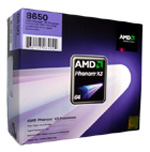 |
The CPU chosen for the AMD HTPC computer is the tri-core Phenom 8650 based on the Toliman core. The three CPUs each run at 2.3GHz with a 512KB cache. The total power requirement of 95W works fine with our motherboard, but you can choose a lower power CPU if that is a large concern. We hesitate to call a Phenom CPU with three cores a low-end chip, but this is certainly one of the most reasonable Phenoms you can buy. It has plenty of power to take your AMD HTPC to most anywhere you chose to go.
With DDR2-800 so reasonable these days we equipped the HTPC with 4GB of G.Skill memory. We aren't really interested in overclocking this HTPC (though it's technically still possible), and spending additional money on even higher performance RAM just doesn't make sense. 4GB of memory, however, does make perfect sense in an HTPC box, as that will keep the UI snappy even when streaming large movies.
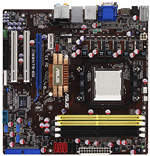 |
The $90 ASUS M3N78-EM is based on the NVIDIA GeForce 8300 chipset. The board features one PCI-E x16 slot, one PCI-E x1 slot, two PCI slots, 8GB memory support, NVIDIA Gigabit LAN, 7.1 HD audio, 12 USB ports, five 3Gb/s SATA ports with RAID support, IEEE 1394a, one eSATA port, HDMI/DVI/VGA output, and full support for the Phenom 140W processors. This board offers overclocking capabilities along with being a top-notch HTPC capable board. We highly recommend the GF8200/8300 series for the HTPC market due to hardware accelerated BD playback, multi-channel LPCM output, and very good application performance.
 |
As we discussed in the HTPC introduction, we did not include a TV tuner in the configuration since most end-users are now distributing their cable and satellite feeds. Few users, therefore, have any real need for a TV tuner card. There's something else to consider in this, and that is the US government mandated February 19, 2009 deadline to end analog broadcasts. If you truly need a Digital TV tuner, one option that is pretty unique on the TV tuner side is the HD HomeRun from Silicondust USA. This is a dual HDTV tuner/recorder that functions over a network and provides ATSC/QAM support. The price of $169 is more than many other options, but this is arguably a more flexible overall solution - particularly with the mandated move to digital in just a few weeks.
What's the point of having an HTPC if you don't have a lot of storage space? To that end, we selected a newly affordable 1TB (1000GB) Western Digital Caviar Green WD10EACS SATA hard drive at just $105 - an astonishing 10.5 cents per GB! The WD Green is a variable speed energy saving design that we found to be among the quietest drives we have ever evaluated. For an HTPC, quiet operation is paramount, and this WD Green will not disappoint. The WD Green is a bit slower than true 7200RPM 1TB drives, but the real performance difference is very minor.
Another excellent HD option is the Seagate Barracuda 7200.11 ST31000333AS 7200RPM 1TB at $110. Performance of this 1TB drive has been exemplary in early testing at AnandTech, and the drive has proved to be reasonably quiet. Seagate also makes a super-reliable 1TB drive optimized for video storage and retrieval called the Seagate SV35.3 ST31000340SV 1TB at $150. This "video" Seagate features 24x7 reliability with >1 million hours MTBF and improved read/write reliability. For those willing to pay the small premium the "video" Seagate drive would be a good choice.
 |
The optical drive is certainly an upgrade to the entry and budget systems since a reasonable HTPC requires Blu-Ray playback capabilities. The LG Black 6X Blu-ray is an SATA drive that fits the bill without breaking the bank. It provides 6X Blu-Ray playback and the fastest recording and playback of DVD and CD media. Current price is around $120, but this drive sometimes goes on sale for $100 so look out for specials. There are also sub-$100 Blu-Ray options from Lite-On and a 6X Blu-Ray player at $105. We do not have much experience with this Lite-On drive, but Lite-On drives in the past have proved fairly reliable. That would make the Lite-On 6X Blu-ray a more reasonably priced alternative where every penny counts.
 |
The HTPC case is one of those very personal options in building an HTPC computer. Some like the small cube form factor that can easily hide next to books on a shelf, while others prefer the audio component look. Our case choices will cover both options.
While it is fairly expensive for the actual size, we find the cube-like Lian Li PC-V350A a gem of a small aluminum cube. The PC-V350A is the silver version and the PC-V350B is the black version. Both colors sell for the same $110. There is enough space for all the typical HTPC requirements, with good cooling and above all the important blessedly quiet operation. Only a Micro ATX motherboard will fit and there are two 5.25" external drive bays that can open right or left and two internal 3.5" bays for hard drives. Front ports for USB, audio, and Firewire (IEEE 1394) are featured behind a door to keep the appearance sleek and uncluttered. At just 10.3" tall by 11" wide, the V-350A fits in most bookcases just fine, but the depth of 14.7" makes the Lian Li most comfortable on deeper 16" shelves (279mm W x 262mm H x 373mm D).
 |
The little Lian Li is coupled with a robust PC Power & Cooling Silencer 500W power supply that you can currently buy for a bargain $50. You can spend more on a PSU but you will be hard pressed to find a unit as quiet and reliable as the Silencer. It also has enough power for whatever video card you might throw in your HTPC in the future - though high-end GPUs are at odds with the silence most desire from HTPCs.
 |
If you prefer the "audio component" look in your HTPC an excellent alternative is the Silverstone LC13B-E Media Center case. It is worth mentioning that if you choose a full size ATX motherboard for your HTPC it will fit in the Silverstone. The Silverstone is presently on rebate, so the normal $115 price is reduced to $95 after the $20 rebate.
Since most will place their HTPC near their HDTV or big screen monitor, a wired keyboard and mouse are not really very useful in most setups. Control is more often done from across the room, so we selected a wireless RF Logitech keyboard and mouse. At just $25 for the pair, the Logitech Cordless Desktop EX100 keyboard/mouse package is a great value. This is also the HTPC preferred RF wireless set, which does not require "line of sight" that is needed for IR wireless.
The final price of the AMD HTPC comes to just $736. That is a real bargain considering the tri-core Phenom CPU, 4GB of memory, 1TB hard drive, and quiet Lian Li aluminum case with a PC Power & Cooling Silencer 500W PSU. You can certainly spend even less on a basic HTPC box, but we doubt you can build a more powerful or quiet system for the same money.
Intel HTPC
To be honest, if there's one system in this roundup that is likely to get a lot of comments and criticisms, it's going to be the HTPC configuration. That's not to say that our particular configuration is unreasonable, but in the HTPC market we will invariably encounter many differing opinions about what is necessary and what is not. We detailed our assumptions about the HTPC configurations tin the introduction to the AMD HTPC System. You may want to look back at the considerations. We assume the end-user has already selected an HDTV or monitor and a sound system. Very few end-users need a TV tuner anymore so we are not making that recommendation. We also assume the primary use of the HTPC computer is to play, store, and stream Blu-Ray movies and other video entertainment.
| Intel HTPC System | ||
| Hardware | Component | Price |
| Processor | Intel Pentium Dual-Core E5200 Wolfdale (Dual-core 2.5GHz 65W 2MB Shared L2 800FSB) |
$83 |
| Cooling | CPU Retail HSF | - |
| Video | Onboard | - |
| Motherboard | Gigabyte GA-E7AUM-DS2H NVIDIA GeForce 9400 | $135 |
| Memory | 4GB DDR2-800 - G.Skill F2-6400CL5D-4GBPQ | $40 |
| Hard Drive | Western Digital Caviar Green WD10EACS 1TB SATA 3.0Gb/s Hard Drive - OEM | $105 |
| Optical Drive | LG BD/HD DVD / 16x DVD+/- RW GGC-H20LK | $110 |
| Audio | Onboard | - |
| Case | Lian LI PC-V350A | $110 |
| Power Supply | PC Power & Cooling Silencer PPCS500 500W ATX12V / EPS12V SLI Ready CrossFire Ready 80 PLUS Certified Active PFC Power Supply - Retail | $50 |
| Keyboard and Mouse | Logitech Cordless Desktop EX100 USB RF Wireless Keyboard and Optical Mouse | $25 |
| Operating System | Microsoft Vista Home Premium OEM | $99 |
| Bottom Line | $757 | |
 |
As discussed in the Intel Entry PC, the E5200 is an excellent value point in the Intel CPU line. Anything lower-priced is generally a lot lower in performance, but higher priced CPUs do not gain that much in performance. At $83 the dual-core E5200 is also an excellent match for an Intel HTPC. It doesn't hurt that the E5200 is rated at 65W, which will help keep the HTPC as quiet as possible.
 |
The motherboard for the Intel HTPC is the $135 Gigabyte GA-E7AUM-DS2H featuring the NVIDIA GF9400 chipset. Our motherboard reviews found this chipset and the GF9300 a better choice than G45 in HTPC systems due to superior video playback and overall system performance. A review of the GA-E7AUM-DS2H is scheduled for the near future. You can currently find a combo deal of this motherboard with the Intel Core Duo E7300, which was our choice in the Intel Budget system. At a $15 off combo price that reduces the E7300 net price to $105 making it an extremely good value with this Gigabyte board.
Some users have reported that the stock Intel CPU heatsink touches the chipset heatsink and they found the heatsink fit and worked best by rotating the heatsink 90 degrees. For best results check the fit and best positioning before completing the mount of the heatsink/fan.
The rest of the components are the same as those found in the AMD HTPC system, so please refer to the detailed discussion on the AMD HTPC page.
AMD systems have held the lead for some time in HD video and HTPC boxes. The AMD advantage was large enough that AnandTech hasn't really recommended an Intel HTPC build in the last few buyers' guides. This is the first buyers' guides to include both AMD and Intel HTPC system recommendations. The NVIDIA GeForce 9300/9400 chipsets have done a lot to level the HD and HTPC playing field. While we can't tell you HD playback capabilities are completely equal between AMD and Intel today, we can tell you that both HTPC builds provided smooth, stutter-free Blu-Ray playback. Certainly that is a primary concern for most HTPC system builders. However, if you intend to do video encoding in addition to video playback on your HTPC, the tri-core AMD setup does win out over the base E5200 in that area.
Final Words
The problem with systems under $1000 is that they aren't normally sexy or groundbreaking. Lower end PCs are therefore completely devoid of any of the glitz and excitement associated with the midrange to high-end market. Most consider low-end PCS to be just the Dell or HP special of the week - hardly worthy of consideration as a "real" PC. That perception is really a shame, because the sub-$1000 market is where many PC buyers choose to buy - or are forced to buy because of budget constraints. Today, more than ever, you will get a lot for your money in this market segment. When dual-core CPUs can be choices in Entry PCs, 4GB of DDR2-800 can be bought for $40 or less, and the starter hard drive is a $59 500GB 7200RPM, there truly is value to be had at these price points.
Our entry systems, complete with a 1440x900 monitor and decent integrated graphics, are just $538 for either Intel or AMD. These are prices for a complete system with LCD monitor, keyboard and mouse, and Vista Home Premium OEM Operating System. We can't recall a time where you received better value for your $500. Indeed, the Intel/AMD wars in the CPU space and the NVIDIA/ATI wars in GPUs have created some truly excellent values in the market. This value has been further enhanced by the worldwide recession. It is ironic that the best prices coincide with the scariest economic times, but that is how economies work. If you are in the market for a PC, though, even an entry model, you will be pleased with the values you can find.
A year ago, the entry-level PC cost around $750 and the budget or value PC cost over $1000. Today that $750 price point is the beginning of the budget category. Both our budget PCs are complete systems at less than $850. Both include a Radeon HD 4830 GPU at that price, a 1680x1050 LCD, 4GB of DDR2-800 memory, a 500GB 7200RPM hard drive, and a tri-core Phenom Black Edition or dual-core Intel 1066FSB CPU, Microsoft keyboard and mouse, Vista OS, and a Logitech 2.1 speaker system. Either system will provide excellent performance in general use - much better than you would expect for a system at this price level.
If your budget interests extend to gaming you can substitute a full HD 1080P monitor in a 21.5" 1920x1080 LCD and upgrade to the well-regarded ATI Radeon HD 4870 512MB video card to bring your new system up to current gaming PC standards. This would only add $165 to your system price. That means you can build a 4870 gaming rig with a 1080P 1920x1080 HDMI LCD for just $998. That kind of value did not exist until recently, and that is why it is such a good time to buy and build a new PC.
Finally, who would have thought that an AMD and Intel HTPC could be built with so many features for so little money? You can get 4GB of memory, a reasonable CPU, and graphics fast enough to provide stutter-free and tear-free Blu-Ray playback for a song! Add in 1TB of quiet hard drive storage, a combo 6X Blu-Ray player/DVD burner, and HDMI capable onboard graphics, all wrapped in a Lian Li aluminum case with a PC Power & Cooling 500W Silencer power supply for around $750, including the Vista OS and a wireless keyboard and mouse. The result is tremendous value for the money spent.
As has been pointed out many times in the last few months, AMD and Intel performance are almost price par for low-end to midrange systems. That is to say, a $120 AMD CPU is pretty comparable in performance to a $120 Intel CPU today - and the same goes for $70 and $100 options. Intel still owns the top of the CPU market, but that may be subject to revision in a few days when the AMD Phenom II launches.
This price parity in the sub-$1000 segment is part of the reason so much value is available at such relatively low prices, but CPUs aren't the only values. You can buy what we consider a top ATI HD 4870 1GB GPU for $220 if you shop around, and it will perform as well as or better than yesterday's $500 video card. 500GB is now and entry-level hard drive and 1TB drives offer storage at $0.105 per GB; 1TB at around $100 is now a reality. Memory has also reached commodity pricing levels when we can recommend 4GB of high-speed DDR2-800 for less than $40.
Put it all together and you can buy an excellent entry, budget, or HTPC computer for well under $1000. You can even deck it out with a 1080P monitor and a 4870 video card and still barely reach $1000. It is a good time to be shopping for a new PC. Value is the rule of the day as competition, a mature market, and a lackluster world economy have created great deals in every computer component category… except perhaps when it comes to operating systems (excepting Linux, naturally).
Next week we will take a closer look at midrange systems, recommending system configurations with a broad price range of $1000 to $2000. Many of you will find you can even meet your high-end computer dreams in this price range that was once reserved for the middle of the road PC and the beginning of computer gaming.







